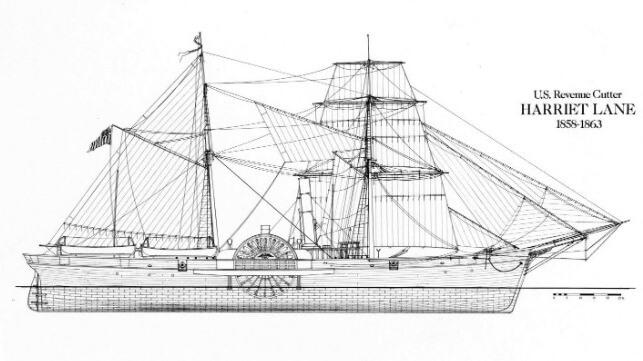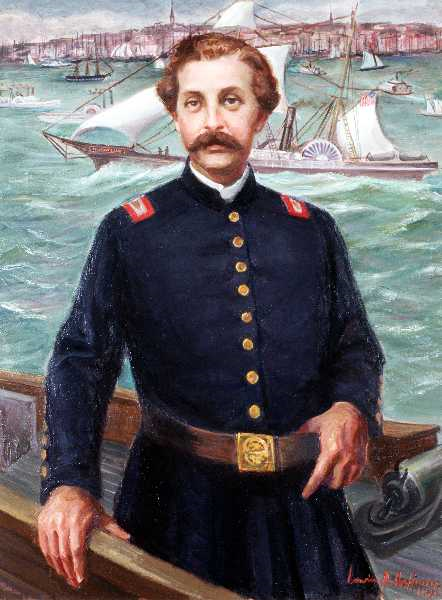Capt. Fraser: The U.S. Coast Guard's Forgotten Visionary

 . . . [Captain] Fraser opposed an Assistant Secretary of the Treasury, and this official’s hostility proved fatal to the Captain’s long career: by an arbitrary abuse of power, the administration in 1856 revoked his commission summarily. Both indefensible and stupid, this action resulted wholly from personal animosity and cost the government one of the most far-sighted and loyal men who ever sailed in the Revenue-Marine. - Stephen Evans, The United States Coast Guard: A Definitive History
. . . [Captain] Fraser opposed an Assistant Secretary of the Treasury, and this official’s hostility proved fatal to the Captain’s long career: by an arbitrary abuse of power, the administration in 1856 revoked his commission summarily. Both indefensible and stupid, this action resulted wholly from personal animosity and cost the government one of the most far-sighted and loyal men who ever sailed in the Revenue-Marine. - Stephen Evans, The United States Coast Guard: A Definitive History
As the quote above indicates, Capt. Alexander Vareness Fraser, first commandant of the service, was a visionary and a man of character. During his four years as head of the United States Revenue Cutter Service, he did his best to professionalize and modernize the service. Many of his innovations were ahead of their time taking place decades after he tried to implement them.
Alexander Fraser was born in New York, in 1804, and attended the city’s Mathematical, Nautical and Commercial School. In 1832, he applied for a commission with the U.S. Revenue Cutter Service. President Andrew Jackson signed his commission as second lieutenant aboard the Revenue Cutter Alert. Fraser served as boarding officer when the service ordered his cutter to Charleston during the infamous “Nullification Crisis” in which South Carolina officials defied federal law requiring merchant ships arriving in Charleston to pay tariffs. During this event, political tempers cooled and a national crisis was ultimately averted.
After the Nullification Crisis, Fraser was offered command of a merchant vessel destined for Japan, China, and the Malayan Archipelago. Upon his return two years later, Fraser received appointment as first lieutenant aboard the Alert. Soon thereafter, Congress passed a law authorizing revenue cutters to cruise along the coasts in the winter months to render aid to ships in distress. Fraser returned to New York before any cutters actually started this new duty, and he applied for it, taking command of the Alert when its captain was too sick to go to sea. He spent three years performing this mission, becoming the first cutter captain to carry out the service’s official search and rescue mission.
In 1843, Treasury Secretary John Spencer created the Revenue Marine Bureau to centralize authority over the cutters within the department and appointed Fraser head of the Bureau. As head of the service, Fraser busied himself with all financial, material and personnel matters concerning the revenue cutters. During his first year in office, he assembled statistics and information for the service’s first annual report and he outlawed the use of slaves aboard Revenue Cutters. He instituted a merit-based system of officer promotion by examination before a board of officers. He also began the practice of regularly rotating officers to different stations to acquaint them with the nation’s coastal areas. He tried to improve the morale of the enlisted force, raising the pay of petty officers from 20 dollars a month to 30; however, he also prohibited the drinking alcohol aboard cutters. He inspected lighthouses regularly and tried to amalgamate the Lighthouse Board with the Revenue Marine Bureau, a merger that finally occurred nearly 100 years later. With construction of the 1844 Legare-Class cutters, Fraser introduced the service to iron hulls and steam power. However, these hull materials and motive power were experimental at the time and the new cutters proved unsuccessful.
In November 1848, Fraser completed his four-year tenure as commandant. For his next tour, Fraser asked for command of the new cutter C.W. Lawrence on a maiden voyage that would round Cape Horn bound for the West Coast. This journey placed him in charge of the first revenue cutter to sail the Pacific Ocean. The Lawrence arrived at San Francisco almost a year after it departed New York and, during this odyssey, Fraser took it upon himself to educate his officers in navigat ion and seamanship much like the Revenue Cutter Service School of Instruction after its founding in 1876. Unfortunately, all of these trained officers resigned their commissions when they reached California to join the Gold Rush.
On the San Francisco station, Fraser had an exhaustive list of missions to perform with a crew depleted by the lure of gold. He not only enforced tariffs and interdicted smugglers, he provided federal law enforcement for San Francisco, relieved distressed merchant vessels and surveyed the coastline of the new state. Fraser had a busy time with 500 to 600 vessels at anchor in San Francisco harbor, many with lawless crews. There were no civil tribunals to help with law enforcement, so Fraser did his best to enforce revenue laws while aiding shipmasters in suppressing mutinies.
After completing his assignment on the West Coast, Fraser returned to New York City. There, he was suspended and investigated on the charge of administering corporal punishment in San Francisco. The case was unsuccessful so he retained his captaincy in New York. In 1856, the merchants of New York decided they needed a new cutter because the port had become such an important commercial center. Fraser favored building a steam cutter and visited Washington to lobby for new construction. Congress appropriated funds for the steam cutter Harriet Lane, considered the most advanced steam-powered warship of its day, which later earned fame in the Civil War.
Because Fraser had lobbied Congress directly without permission from the Department of Treasury, his commission was revoked in 1856. He went into private business in New York as a marine insurance agent, but he retained a sincere interest in military service. He applied for reinstatement during the Civil War and, in 1863, President Abraham Lincoln signed a captain’s commission for Fraser. By then, however, personal matters intervened and Fraser regretfully declined the appointment. He died in 1868 at the age of 64 and was laid to rest at Brooklyn’s famed Green-Wood Cemetery.
Alexander Fraser introduced the service to professionalization, new technology and moved a reluctant service toward reforms and innovations that would take place long after his death. As the first commandant, Fraser’s foresight and enlightened leadership set the Service on course for growth and modernization. He was a true seaman, a visionary and a member of the long blue line.
William H. Thiesen, Ph.D. is the Coast Guard Atlantic Area Historian.
This article appears courtesy of The Long Blue Line and may be found in its original form here.
The opinions expressed herein are the author's and not necessarily those of The Maritime Executive.
